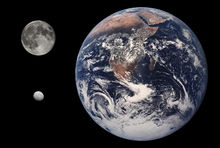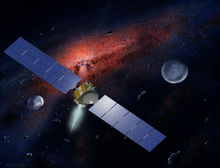 Ceres, minor-planet designation 1 Ceres, is the largest asteroid and the only dwarf planet in the inner Solar System, orbiting in the asteroid belt between the orbits of Mars and Jupiter. It is a rock–ice body 950 km (590 mi) in diameter and the smallest identified dwarf planet. It contains about one-third of the aggregate mass of the whole asteroid belt. Discovered on 1 January 1801 by Giuseppe Piazzi, it was the first asteroid to be identified, though it was classified as a planet at the time. It is named after Ceres, the Roman goddess of growing plants, the harvest, and motherly love.
Ceres, minor-planet designation 1 Ceres, is the largest asteroid and the only dwarf planet in the inner Solar System, orbiting in the asteroid belt between the orbits of Mars and Jupiter. It is a rock–ice body 950 km (590 mi) in diameter and the smallest identified dwarf planet. It contains about one-third of the aggregate mass of the whole asteroid belt. Discovered on 1 January 1801 by Giuseppe Piazzi, it was the first asteroid to be identified, though it was classified as a planet at the time. It is named after Ceres, the Roman goddess of growing plants, the harvest, and motherly love.The surface of Ceres is probably a mixture of water ice and various hydrated minerals such as carbonates and clay minerals. It appears to be differentiated into a rocky core and icy mantle, and may harbor an ocean of liquid water under its surface. From Earth, the apparent magnitude of Ceres ranges from 6.7 to 9.3, and hence even at its brightest it is still too dim to be seen with the naked eye except under extremely dark skies.
The unmanned Dawn spacecraft, launched on 27 September 2007 by NASA, is expected to be the first to explore Ceres after its scheduled arrival there in February 2015. After having orbited asteroid 4 Vesta since July 2011, the spacecraft departed for Ceres in September 2012.
On 22 January 2014, ESA scientists reported the detection of water vapor emissions from several localized mid-latitude regions of Ceres. This first definitive detection was made by using the far-infrared abilities of the Herschel Space Observatory. The finding is unexpected because although comets typically display "sprout jets and plumes", asteroids do not generally exhibit such features.
Status
The classification of Ceres has changed more than once and has been the subject of some disagreement. Johann Elert Bode believed Ceres to be the "missing planet" he had proposed to exist between Mars and Jupiter, at a distance of 419 million km (2.8 AU) from the Sun. Ceres was assigned a planetary symbol, and remained listed as a planet in astronomy books and tables (along with 2 Pallas, 3 Juno and 4 Vesta) for about half a century.As other objects were discovered in the area it was realized that Ceres represented the first of a class of many similar bodies. In 1802 Sir William Herschel coined the term asteroid ("star-like") for such bodies, writing "they resemble small stars so much as hardly to be distinguished from them, even by very good telescopes". As the first such body to be discovered, it was given the designation 1 Ceres under the modern system of asteroid numbering.
The 2006 debate surrounding Pluto and what constitutes a 'planet' led to Ceres being considered for reclassification as a planet.A proposal before the International Astronomical Union for the definition of a planet would have defined a planet as "a celestial body that (a) has sufficient mass for its self-gravity to overcome rigid-body forces so that it assumes a hydrostatic equilibrium (nearly round) shape, and (b) is in orbit around a star, and is neither a star nor a satellite of a planet". Had this resolution been adopted, it would have made Ceres the fifth planet in order from the Sun. It was not accepted, and in its place an alternate definition came into effect as of 24 August 2006, carrying the additional requirement that a "planet" must have "cleared the neighborhood around its orbit". By this definition, Ceres is not a planet because it does not dominate its orbit, sharing it with the thousands of other asteroids in the asteroid belt and constituting only about a third of the total mass. It is instead now classified as a dwarf planet.
It is sometimes assumed that Ceres has been reclassified as a dwarf planet, and that it is therefore no longer considered an asteroid. For example, a news update at Space.com spoke of "Pallas, the largest asteroid, and Ceres, the dwarf planet formerly classified as an asteroid", whereas an IAU question-and-answer posting states, "Ceres is (or now we can say it was) the largest asteroid", though it then speaks of "other asteroids" crossing Ceres's path and otherwise implies that Ceres is still considered an asteroid. The Minor Planet Center notes that such bodies may have dual designations. The 2006 IAU decision that classified Ceres as a dwarf planet never addressed whether it is or is not an asteroid, as indeed the IAU has never defined the word 'asteroid' at all, preferring the term 'minor planet' until 2006, and 'small Solar System body' and 'dwarf planet' after 2006. Lang (2011) comments, "The [IAU has] added a new designation to Ceres, classifying it as a dwarf planet. ... By [its] definition, Eris, Haumea, Makemake and Pluto, as well as the largest asteroid, 1 Ceres, are all dwarf planets", and describes it elsewhere as "the dwarf planet–asteroid 1 Ceres". NASA continues to refer to Ceres as an asteroid, saying in a 2011 press announcement that "Dawn will orbit two of the largest asteroids in the Main Belt", as do various academic textbooks.
Exploration
The Dawn spacecraft, launched by NASA in 2007, orbited asteroid 4 Vesta from 15 July 2011 until 5 September 2012 and is continuing on to Ceres. It is scheduled to arrive there in February 2015, five months prior to the arrival of New Horizons at Pluto. Dawn will thus be the first mission to study a dwarf planet at close range.
Dawn's mission profile calls for it to enter orbit around Ceres at an altitude of 5,900 km. The spacecraft will reduce its orbital distance to 1,300 km after five months of study, and then down to 700 km after another five months. The spacecraft instrumentation includes a framing camera, a visual and infrared spectrometer, and a gamma-ray and neutron detector. These instruments will examine Ceres's shape and elemental composition.

This work is licensed under a Creative Commons Attribution-ShareAlike 3.0 Unported License.




 03:38
03:38
 Planet Worldwide
Planet Worldwide



 Posted in:
Posted in:
0 comments:
Post a Comment